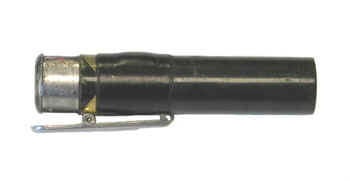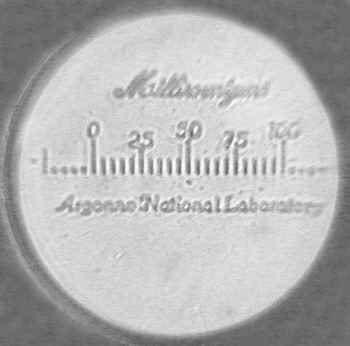Shonka Pocket Dosimeter (ca. 1950s)

This unusual dosimeter, developed and patented by Frank Shonka in the 1950s, was routinely used at Argonne National Laboratory for several decades. The most obvious of its unique features is that the end of the dosimeter does not have to be pointed towards the light for it to be read. In fact, that would be the wrong thing to do! The light enters the dosimeter through the transparent wall of the dosimeter barrel just below the eyepiece (see arrows in photograph below). In other words, the dosimeter can be read at almost any angle. Ya gotta love it.
Another ingenious feature is that you can easily vary the volume of the ionization chamber and thereby adjust the dosimeter's sensitivity. This facilitates the production and calibration of the instrument.
Accidental discharge of the dosimeter is prevented by the use of an unusual charging mechanism. Rather than using a flexible bellows to connect the charging contact at the end of the dosimeter to the electroscope fiber, it uses a magnetically activated sliding pin. Tracerlab incorporated this particular idea into its SU8 pocket chamber.


Finally, the dosimeter uses a particularly rugged carbon fiber rather than the quartz fiber typically employed in pocket dosimeters. To demonstrate how rugged and dependable his invention was, Frank Shonka would let a visitor note the position of the fiber on the scale, and then take the dosimeter and throw it against the wall. The fiber wouldn't budge!
Size: 9/16” diameter and 2.75” long
Donated by Joe Shonka.
References
- Shonka, F., Okleshen, A.J., and Selman, R.F. Radiation Measuring Device. U.S. Patent Number 2,687,480, August 24, 1954.
- Joe Shonka, personal communication.
